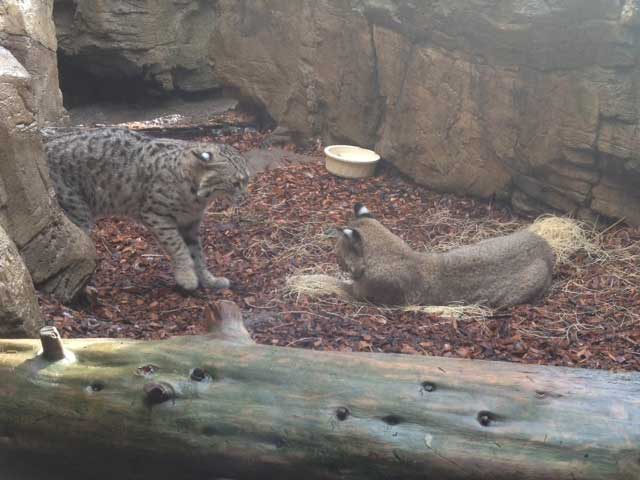Blog
Animal Keepers Want to Know – What’s that Animal Saying?
CuriOdyssey’s animal keepers may not always know what our animals are thinking, but observing body language can help a keeper figure out what an animal is trying to “say” to better serve their needs. Body language is communicated through nonverbal cues such as an animal’s stance and gestures toward another animal.
Animals use body language to attract a mate, establish territory, work together and scare off predators. For example, snakes will often rattle their tails or coil into a striking position to warn predators they are intimidating and ready to fight to back. Some newts will flip over and expose a brightly colored belly to scare animals away. Male birds will often attract females during breeding season by showing off their plumage with elaborate dances. Other animals may bare their teeth because they want personal space and will bite if provoked.

Above is a picture of our two bobcats (Lynx rufus), Frankie and Caro, play fighting. Play fighting among cats means there is no growling, yowling, or teeth barring; it is simply silent play that helps cats practice skills and burn off energy. Frankie (left) appears to be walking toward Caro with his ears flattened and turned back. This indicates that at the moment, he feels threatened by Caro and may be turning his ears to protect them in an altercation. Caro (right) is lying down with confidence; His ears are upright and he is looking straight at Frankie.

Soon after the first picture was taken, Caro stood up. Frankie responded by plopping down and assuming a power position; he’s inviting Caro to a wrestling match!
Birds also use body language to communicate how they feel. Our animal keepers have noticed that when alert or threatened, Solo, the great horned owl (Bubo virginianus) will make the tufts of feathers on her head stand up. These false horns make her appear larger and intimidating to predators.

Similarly to great horned owls, other birds use body language for intimidation. Below is a picture of an animal keeper feeding our Swainson’s hawk (Buteo swainsoni), Yzma. Yzma is preforming a behavior called “mantling,” where she droops her wings and brings them forward, fanning out those feathers. By mantling, she is guarding her spoils from the view of others. Yzma is signaling to our animal keeper and the photographer that she has no desire to share her food.

Tesla, the American kestrel (Falco sparverius), is another CuriOdyssey resident who uses a lot of body language to let keepers know how she is feeling. By fanning out her wings and turning her back towards another animal, she is communicating that she wants to be left alone. Tesla is more likely to display this type of behavior when she is on her perch because it is her territory.

Although animal keepers can never know exactly what an animal is thinking, their body language gives them clues. What do you think Darwin, the African hedgehog (Atelerix albiventris), is trying to communicate through his body language? Does he appear friendly and inviting? Perhaps he is making his quills look pointy and scary? Leave your guesses in the comment section below!

– post and most photos by Rachael Tom; photo of Swainson’s Hawk by Alejandro Maestas
Join the CuriOdyssey Community
LOCATION
1651 Coyote Point Drive
San Mateo, CA 94401
Ohlone Land Acknowledgement
650-342-7755
info@curiodyssey.org
CuriOdyssey is a 501(c)(3) non-profit, Tax ID 94-1262434



